Basic Principles of Religious Beliefs found in Nidana:
-
People don't believe in worshiping sculptures and statues. Most of the people in village believe in unity of God and believe that God's abode is one's own soul rather than any building made up of iron and cement
-
People hate malpractices on the name of religion.
-
Village is declared as "Saand Chhod Rakhya sai" by fraud and hypoctrites. They say so because most of them have or had a bitter experience for misguiding the village community on the name of religion.
-
People have very sharp instinct of recognizing such practices on scale of reality and viability.
-
People are sharply against any such religious practice which may involve the youth of village in drugs and drinking habits. That is why hardly any hypocrat dare to pass a night in Nidana village. Except the saints of highest quality and achievements whom villagers give due respect, villagers never hesitate to keep continuing on their record of teaching a lesson to all other havocs each time.
-
By being in the business of agriculture, it generates the sense of being closest to God and stay loyal to your work and efforts thus everyone knows how to stay in touch with God.
Interesting live experience on "Saand Chhod Rakhya Sai" trademark of village: In the days of my childhood, one day I was working on my fields with my seeries
(in professional and urban terms - with my servants and in village terms - with my partners), suddenly two saints passed by us. They asked us by fingering toward our village that which is this village. Then one of my seeries told them it is Nidana. Listening to this one of them quickly responded back to his other fellow that we will not be going to this village for overnight stay. The other asked in suspense, why so? The first one replied that this village is declared as "Saand Chhod Rakhya Sai". And they left for another village.
Then in curiosity, I asked my same seeri that what does it mean. He replied me that "बेटा, इसका मतलब सै अक इस गाम में झूठे और पाखंडी साधू-संतों को जूते पड़ते हैं सो बेहतर होगा कि हम इस गाँव में ना जाएँ." means this village is notoriously famous for teaching lessions to fraud and hypocrites so better stay away from this village. And me and my all seeries roled in laughter piles.
As my seeri is grand-father to me in my village relation, he further added that dear son, there was a very big
dera in our village in ancient times but due to these un-ethical and hypocratic practices, villagers ruined the dera and since then there is no big temple in our village except
"Dada Nagar Kheda" and
"Debi Maai", which in fact are not temples but memorial monuments of village's establishment and ancestors. And that is why you never see any public religious function in village. And since the day of that incident of dera, our village got the trademark of "Saand Chhod Rakhya Sai" by such hypocrats.
Religions and Deities:
Nidana and Arya Samaaj: As said in History section of Introduction section and point one above village people like the theory of unity of God and its abode in each living soul rahter than outsides anywhere. Thus village people adore the Arya Smaaj closest to their hearts. Nidana was and is known as one of the the leading iconic identity of Arya-Samaaj. It is famous for its Arya Samajik fellowship and practices. When around 1905 (exact date to be confirmed), the Jat Akhil Bhartiya Mahasabha decided to adopt Arya Samaaj fellowship, so adopted by Nidana same time.
The holy Satyaarth Prakash and Vedas: Web links and soft-copies of holy “Satyarth Prakash” are available on e-Library section of Info-center page.
Arya Samaaj personalities from Nidana: I have been among those lucky persons who saw many Arya-Samajik movements and the personalities related to these movements in my village. Below is the list of personalities with their work on social reforms and infra-development of Nidana under Arya-Samaaj influence:
- Swami Ratandev Saraswati: Thou contributions to Nidana were the expansion of Kanya Pathshala (in pursuit of thou dream of opening up a Kanya Gurukul), Anti-Smoking and Anti-Alcohol Movements in early 90's and late 00's.
- Ramapl Shastri Ji: Thou contribution to Nidana was establishment of Old High School in 1935.
- Late. Dada Choudhary Jaagar Singh Malik: Thou donated the full required land for school Old High School in 1935 itself.
-
Kanya Pathshala room donators: 17 distinguished village personalities who donated one room each for Kanya Gurukul establishment.
Critics: If to see the life of Swami Dayananda from inside deep, thou believed, practice and toiled for continuous change and thus preached to keep revising and reforming the principles of Arya Smaaj, which unfortunately is not happening at the required pace and time. He preached that to keep Arya Samaaj live and validated in all arenas, it will require a continuous study and debate. But saints and Arya Smaaji’s seen rarely doing it.
Religions: There are two religions followed by Nidanias, Hinduism and Muslim; former is practiced by 95 to 97% of the population except Blacksmiths, Potters, Dooms and Telies. Dooms are the only single Muslim community of village where as Blacksmiths, Potters and Telies shares both religions.
Web links as well as soft copies of Mahabharta, Ramanyana, Bhagwad Geeta and Kuraan are available at NH Library section of Info-center page.
Common deities of village:
Arya Samaaj: Please refer to Arya-Samaaj section above.
Dada Nagar Kheda: Similar to any other village of Haryana, Nidana devotes to its ancestral forefathers a regular prayer at Dada Nagar Kheda. Dada Nagar Kheda is the holy place where the prime ancestors of village laid the first stone of village establishment and since then it stands tall as an immortal memorial of village's birth. Its purity and attachment to very first ancestors of village make it the most sacred and worshiping deity of village.
Everyone who is getting married, first does worship here for blessings of “Dada Nagar Kheda” for a happy and prosperous married life. The new brides also are requisite to take the oath of village esteem, customs and values with blessings of “Dada Nagar Kheda” at their first day of arrival in village. My village Dada Nagar Kheda is situated at central point on South-Central Avenue of village. It is a small white-washed tomb having no statue or ideal inside and maintained by villagers regularly.
Individual (group specific) deities of village:
Dada Sat Sahi Nirakar: The 800 years old deity for a particular group of villagers. The holy shrine of Dada Molu Ram Ji (perish of chrismatic holy saint from Jat community) is established in neighboring village of “Kharak Ram Ji”. Dada is addressed as “Ram Ji” and “Sat Sahi Nirakar” in general public and has a huge number of followers spread all over India, mainly from Haryana and western UP.
No idealism just worship of Jyoti: There is no picture or statue to worship, a shrine with a “DIYA” which burns for 24*7 on ghee. All wishes prayed with holy heart and true feelings on Dada’s shrine get fulfilled.
Shrine’s Campus: There are three major spots, the prime and major campus in the green-fields of south-western periphery of Kharak-Ram Ji village. Second temple is inside the village. Third temple of importance is just on the outskirts of village’s inhabitant and called as shed of Dada’s cow.
Day of worshiping and celebration: The holy day of worshiping Dada is “Purnamaashi” of each Vikrami Samvat calendar month but the "Holi and Phaag" are the most sacred celebrations. A big fair and wrestling dangals are organized in Kharak Ram Ji on this occasion.
Shrine’s management: The shrine’ maintenance and development is seeing its golden period for last many years under the governance of his highness main priest Shri. Sukhbir Singh Ji. He is a young and charismatic person of just 32 year old. He has shaped the shrine’s campus in a modern architectural way and has given a scintillating look to it. Side photo.
Tilla and Karseva: About 100 feet high tilla is the focal of main worship. On an average lakhs of people visit the shrine every year and do karseva like digging and taking the dug soil to top of the tilla.
Daadi Chorde: The deity of a particular group of villagers, origin goes back to Nidani village, more details will be added soon.
Debi Maai: Deity of a particular group of village. Similar to Dadi Chourde. Every asthmi of month is the sacred day for Debi Maai.
It is established on the banks of Debi-Maai Johdi, the sacred and holy Johad of ancient times of village. This johad is the witness of times when people used to drink and use the water of this pond in their regular life. At that time it was specially preserved for human use only.
Sayyad: The Muslim deity of village. There are two “Madhies” established on extreme North-East and South-West bordering corner of village. More details will be added soon. |
|
"Shri Dada Nagar Kheda" - the holiest and most sacred shrine of the village |
|
Holy Shrine of Shri Dada Sat Sahi Nirakar-1 |
|
Holy Shrine of Shri Dada Sat Sahi Nirakar-2 |
|
Dadimai Chaurde Rani |
|
Holy Shrine of Village' Debimai |
Baakhkhe waali maata: Deity resides at the Bakha pond of village and worshiped by a big sect of villagers.
Kabeerpanthi Madhi: Saffron color madhi of village's Kabeerpanthi community. Dhanak community of village worships her.
Googa Medi: Googa Medi is believed to be the biggest deity of Indian Farming Community so for us and worshiped by all people of village. It is celebrated on the Navmi of Krishan paks of Badhvin month of Vikarmi Samvat year calendar. On this day all brothers (who got Raakhi stitched on their wrists from their sisters just 9 days ago on the day of Rakhsha Bandhan), send their Raakhies to Googa Peer via thou representatives who collect Rakhies and donations from village to village, beating derus and singing sagas of Googa Peer Ji, having bunch of Peacock-feathers tied to one end of wooden-stick in their hands. Rakhies are given to them in belief that now Googa Peer is the devotional power to protect them as well as their loving sisters.
Mythological Gods: Beside above mentioned relgional and local religious beliefs, villagers adore and worship mythological Gods too, out of which followings are most sacredly considered:
Lords |
 |
 |
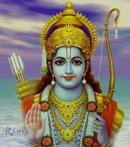 |
 |
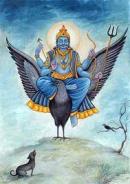 |
Lord Hanumana |
Lord Shiva |
Lord Rama |
Santoshi Maa |
Shani Maharaj |
Brief: There is no village or town in North India a minimum vide of worshipers of Lord Hanumana. Youth of Haryana is especially devoted to Hanumantha. An unforgettable hero in the great epic "the Ramayana". The symbol of courage, loyalty and mature wisdom. |
Brief: Biggest God of village. Destroyer or Transformer of universe. The most powerful god in hinduism. Shiva is seen as the Supreme God and has five important works: creator, preserver, destroyer, concealer, and revealer (to bless). |
Brief: Rama's life and journey is one of adherence to dharma despite harsh tests of life. But he seems hapless in providing justice to life of woman in a male dominant society. His life best defines the committment towards the pricinpal of one woman for one man. |
Brief: She is venerated as "the Mother of Satisfaction". Most popular devotee among village women especially the unmarried girls. The practice fast on each Friday in due respect to her. |
Brief: Shani is embodied in the planet and is the Lord of Saturday. Shani is a deva and son of Surya. He is the elder brother of Yamaraj. Village ladies occasionaly and individually perform "Baar Dhukaai" on each saturday to keep there houses away from shins and devils. |
Maharishies |
 |
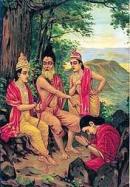 |
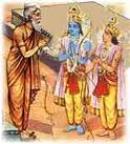 |
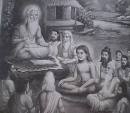 |
 |
Maharishi Balmiki |
Maharishi Vishwamitr |
Maharishi Bhardwaj |
Maharishi Vashisth |
Maharishi Parsuram |
Brief: A maharishi, who proved that you can change your fate by changing the line of your "Karma", his journey of becoming God from a goon is testimony to it. He hold the honor of writing Hindu"s greatest claimed epic "Ramayana". He was the rishi to abode devi Seeta during her excile and was teacher to Luv and Kusha. |
Brief: Vishwamitra tested the truthfulness of Harischandra. In him we see a confluence of three high qualities - valour, knowledge and sympathy - which have made him great. He wanted to have "Nandini" a divine cow from Maharishi Vashisth but this incident turned his path to divinism. |
Brief: A Sage of the Vedic period - a great seer who attained extraordinary scholarship and power of meditation. An enlightened man who used his might for punishing the wicked and protecting the poor and the weak. |
Brief: Vasishta was a great ascetic. He was the preceptor of great men like Sri Rama and Harischandra. He had conquered anger and desire. He was a great saint who humbled insolent men. |
Brief: He traversed and earth twenty-one times and punished evil - doers who were harrassing the people. Parashurama is recognised as a parallel incarnation of God Vishnu, in sam period of Lord Rama. He is also for killing his own mother for the shake of honor. |
Note: All above mentioned local and mythological deities, lords and maharishies are believed to be the heartiest of villagers even though NH disclaimes any such authority believing and respecting the independence of belief of individual.